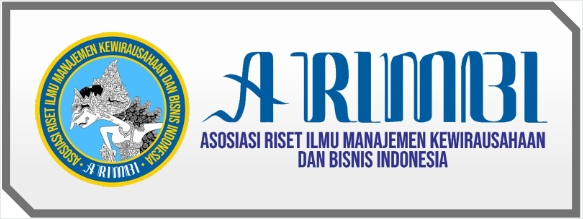Peran Guru dalam Menumbuhkan Intensi Berwirausaha pada Siswa Tuna Rungu di SMPLB Karya Mulia V Surabaya
DOI:
https://doi.org/10.30588/jmp.v7i1.322Keywords:
entrepreneurship, entrepreneurship intention, teacher, deaf studentsAbstract
This research is motivated by the lack of entrepreneurial intention of deaf students in SMPLB-B (Junior High-School for Disabled Children Type B) Karya Mulia V Surabaya, Indonesia in which so many alumni became laborers or even unemployed. Entrepreneurship intention is one of predisposition factors that determine a person's entrepreneurial behavior. One of which various aspect determines how much a person's intention to perform a behavior is the social environment in a student's life, especially teachers. This research also shows that the intention of entrepreneurship can be nurtured since an earlier age through education. As the student’s main educator, teachers play an important role in the process. This article discusses how the role of teachers through parenting is done to foster entrepreneurship intention of the students by using theories of planned behavior.
References
Ajzen, I. (1991). The Theory of Planned Behavior. Organizational Behavior and Human Decision Processes, 50(2), 179-211.
Andika, M., & Madjid, I. (2012). Analisis Pengaruh Sikap, Norma Subyektif dan Efikasi Diri Terhadap Intensi Berwirausaha Pada mahasiswa Fakultas Ekonomi Universitas Syiah Kuala. In Eco-Entrepreneurship Seminar & Call for Paper: Improving Performance by Improving Environment, 190-196.
Arkush, R. D. (1984). If Man Works Hard the Land Will Not Be Lazy: Entrepreneurial Values in North Chinese Peasant Proverbs. Modern China, 10(4), 461-479.
Badan Pusat Statistik. (2012). Keadaan Ketenagakerjaan Agustus 2012. Berita Resmi Statistik Badan Pusat Statistik, (74/11).
Bandura, A., Reese, L., & Adams, N.E. (1986). Microanalysis of Action and Fear Arousal as a Function of Different Levels of Perceived Self Efficacy. Journal of Personality and Social Psychology, 43(1), 5-21.
Bandura, A. (1997). Self-efficacy The Exercise of Control. New York: W.H. Freeman and Company.
Berkowitz, A.D. (2004). The Social Norms Approach: Theory, Research, and Annotated Bibliography.
Bird, B. (1988). Implementing Entrepreneurial Ideas: The Case for Intention. Academy of Management Review, 13(3), 442−453.
Borsari, B. & Carey, K.B. (2003). Descriptive and Injunctive Norms in College Drinking: A Meta-analytic Integration. Journal of Studies on Alcohol, 64, 331-341.
Carr, J.C. & Sequeira, J.M. (2007). Prior Family Business Exposure as Intergenerational Influence and Entrepreneurial Intent: A Theory of Planned Behavior Approach. Journal of Business Research, 60(10), 1090-1098.
Dipta, I.W. (2005). Model Pengembangan Wirausaha. INFOKOP, 19(1).
Fishbein, M. & Ajzen, I. (1975). Belief, Attitude, Intention, and Behavior: An Introduction to Theory and Research. MA: Addison-Wesley, Inc.
Fishbein, M. & Ajzen, I. (2010). Predicting and Changing Behavior. New York: Psychology Press.
Gecas, V. (1989). The Social Psychology of Self-efficacy. Annual Review of Sociology, 15, 291–316.
Grusec, J.E., & Goodnow, J.J. (1994). Impact of Parental Discipline Methods on the Child's Internalization of Values: A Reconceptualization of Current Points of View. Developmental Psychology, 30, 4-19.
Hill, N.E. & Taylor, L.C. (2004). Parental School Involvement and Children's Academic Achievement Pragmatics and Issues. Current Directions in Psychological Science, 13(4), 161-164.
Kecharananta, N. & Baker, H.G. (1999). Capturing Entrepreneurial Values. Journal of Applied Social Psychology, 29(4), 820-833.
Khuong, M.N. & An, N.H. (2016). The Factors Affecting Entrepreneurial Intention of the Students of Vietnam National University—A Mediation Analysis of Perception Toward Entrepreneurship. Journal of Economics, Business and Management, 4(2).
Knafo, A., & Schwartz, S.H. (2009). Accounting for Parent-child Value Congruence: Theoretical considerations and empirical evidence.
Kristiansen, S., & Indarti, N. (2004). Entrepreneurial Intention Among Indonesian and Norwegian Students. Journal of Enterprising Cuture, 12(01), 55-78.
Krueger, N.F., Reilly, M.D., & Carsrud, A.L. (2000). Competing Models of Entrepreneurial Intentions. Journal of Business Venturing, 15(5), 411-432.
Mueller, S. (2008). Increasing Entrepreneurial Intention: Effective Entrepreneurship Course Characteristics. International Journal of Entrepreneurship and Small Business, 13(1), 55–74.
Obschonka, M., Silbereisen, R.K., & Schmitt-Rodermund, E. (2010). Entrepreneurial Intention as Developmental Outcome. Journal of Vocational Behavior, 77(1), 63-72.
Robinson, P.B., Stimpson, D.V., Huefner, J.C., & Hunt, H.K. (1991). An Attitude Approach to the Prediction of Entrepreneurship. Entrepreneurship Theory and Practice, 15(4), 13-31.
Rosenberg, M.J., & Hovland, C.I. (1960). Cognitive, Affective, and Behavioral Components of Attitudes. Attitude Organization and Change: An Analysis of Consistency among Attitude Components, 3, 1-14.
Schunk, D.H. (1990). Introduction to the Section on Motivation and Efficacy. Journal of Educational Psychology, 82(1), 3-6.
Downloads
Published
How to Cite
Issue
Section
License
Authors who publish with Jurnal Maksipreneur agree to the following terms:
Authors retain copyright and grant the Jurnal Maksipreneur right of first publication with the work simultaneously licensed under a Creative Commons Attribution 4.0 International License that allows others to share (copy and redistribute the material in any medium or format) and adapt (remix, transform, and build upon the material) the work for any purpose, even commercially with an acknowledgment of the work's authorship and initial publication in Jurnal Maksipreneur.
Authors are able to enter into separate, additional contractual arrangements for the non-exclusive distribution of the journal's published version of the work (e.g., post it to an institutional repository or publish it in a book), with an acknowledgment of its initial publication in Jurnal Maksipreneur. Authors are permitted and encouraged to post their work online (e.g., in institutional repositories or on their website) prior to and during the submission process, as it can lead to productive exchanges, as well as earlier and greater citation of published work (See The Effect of Open Access).























